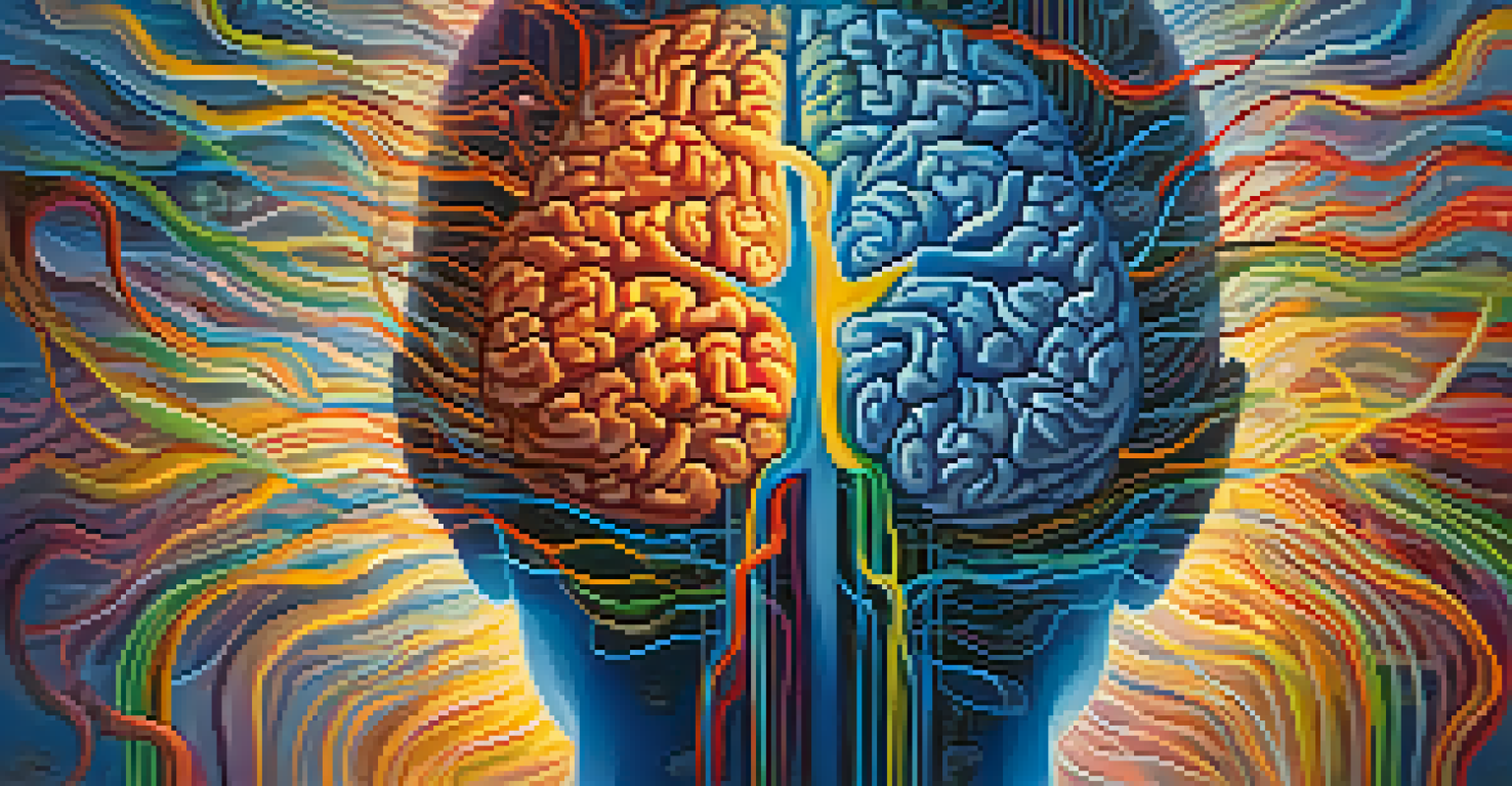The Role of Mescaline in Modern Psychotherapy Research

Understanding Mescaline: A Brief Introduction
Mescaline is a naturally occurring psychedelic compound found in certain cacti, notably peyote and San Pedro. Traditionally used in Native American spiritual practices, it has garnered attention in modern research for its potential therapeutic benefits. Understanding its chemical structure and effects can provide insight into why researchers are exploring its role in psychotherapy.
Psychedelics can help us confront our fears and traumas, and in doing so, they can facilitate healing and emotional breakthroughs.
Unlike some other psychedelics, mescaline is known for inducing a unique state of consciousness characterized by vivid visual experiences and changes in perception. This altered state is believed to facilitate introspection and emotional breakthroughs, making it a compelling candidate for therapeutic applications. As we delve deeper into its effects, we can appreciate the complexity of this ancient substance and its modern implications.
The renewed interest in mescaline is part of a broader resurgence in psychedelic research, which aims to uncover alternative treatments for mental health disorders. In an age where traditional therapies sometimes fall short, mescaline offers a promising avenue for exploration in psychotherapy.
The Historical Context of Mescaline Use
Historically, mescaline has been used in various indigenous cultures for religious and healing purposes. These practices have laid the groundwork for contemporary research, providing valuable insights into the potential benefits of mescaline in therapeutic settings. By understanding its traditional uses, we can better appreciate its significance in modern psychotherapy.

In the mid-20th century, mescaline was explored by psychologists and researchers who noted its ability to induce profound psychological experiences. This era saw a burgeoning interest in psychedelics, with mescaline at the forefront of studies examining consciousness and perception. However, with the rise of regulatory restrictions, much of this research was halted, leaving a gap that modern studies are now striving to fill.
Mescaline's Historical Significance
Mescaline has a rich history of use in indigenous cultures for religious and healing purposes, which informs its potential therapeutic applications today.
Today, as the stigma surrounding psychedelics diminishes, researchers are revisiting mescaline to investigate its potential for treating various mental health conditions. This historical context enriches our understanding of mescaline's role in psychotherapy and highlights the need for continued exploration.
Mescaline's Mechanism of Action in the Brain
Mescaline primarily acts on serotonin receptors in the brain, particularly the 5-HT2A receptor. This interaction is crucial for its psychoactive effects, as it alters mood, perception, and cognition. Understanding this mechanism helps researchers identify how mescaline might aid in psychotherapy by enhancing emotional processing and providing new perspectives.
The use of psychedelics in psychotherapy is not just about the substance; it's about the therapeutic relationship and the context in which these substances are used.
The brain's default mode network (DMN), involved in self-referential thinking, is also affected by mescaline. Research indicates that psychedelics can reduce DMN activity, allowing for a sense of ego dissolution and increased connectivity among different brain regions. This could lead to a more profound therapeutic experience, helping individuals break free from entrenched thought patterns.
By mapping how mescaline interacts with the brain, researchers can refine their approaches to therapy, tailoring treatments to maximize the benefits while minimizing risks. This scientific understanding is essential as we explore the potential of mescaline in addressing mental health challenges.
Current Research on Mescaline in Psychotherapy
Recent studies are exploring mescaline's efficacy in treating conditions like PTSD, depression, and anxiety. Early results indicate that participants often report significant improvements in their mental health following guided mescaline sessions. This research is crucial in establishing mescaline's legitimacy as a therapeutic tool and fostering greater acceptance within the medical community.
One notable study involved participants undergoing psychotherapy in conjunction with mescaline administration, revealing transformative experiences that contributed to their healing journeys. These findings emphasize the importance of the therapeutic setting, which can greatly enhance the benefits of the psychedelic experience. The integration of psychotherapy with mescaline may offer a holistic approach to mental health treatment.
Therapeutic Potential in Psychotherapy
Recent research indicates that mescaline may effectively treat conditions like PTSD, depression, and anxiety when integrated with psychotherapy.
As research continues, it’s essential to approach mescaline therapy with caution and respect, ensuring that guidelines and safety measures are in place. Ongoing studies aim to clarify the best practices for using mescaline in therapeutic contexts, paving the way for its acceptance in mainstream mental health care.
The Therapeutic Benefits of Mescaline
Many individuals who have experienced mescaline report profound insights and emotional healing. These therapeutic benefits can be attributed to the compound's ability to foster a sense of connectedness, both to oneself and to others. This deepened understanding can lead to significant shifts in perspective, which are crucial for overcoming psychological obstacles.
Moreover, mescaline experiences often encourage individuals to confront their fears and traumas in a supportive environment. This process can facilitate emotional release and help participants find closure, making it a powerful adjunct to traditional therapeutic methods. The combination of mescaline and therapy may create a unique space for healing that is difficult to achieve through conventional approaches alone.
As we continue to explore the therapeutic benefits of mescaline, it's essential to highlight that these experiences should be guided by trained professionals. This ensures that individuals can safely navigate their journeys and integrate their insights into their everyday lives.
Challenges and Considerations in Mescaline Research
Despite the promising potential of mescaline in psychotherapy, there are challenges that researchers must navigate. Legal restrictions and regulatory hurdles can impede the progress of studies, making it difficult to gather comprehensive data. Additionally, the stigma surrounding psychedelics can deter participants from engaging in research, limiting our understanding of mescaline's full range of effects.
Another consideration is the variability of individual responses to mescaline. Factors such as personal history, mental health status, and environmental context can all influence how someone experiences mescaline. This variability necessitates a nuanced approach to research and treatment, ensuring that the unique needs of each individual are addressed.
Challenges in Mescaline Research
Legal restrictions and the stigma surrounding psychedelics pose significant challenges to researchers studying mescaline's effects and therapeutic benefits.
As the field of psychedelic research evolves, addressing these challenges will be vital for unlocking mescaline's potential. Ongoing dialogue among researchers, therapists, and policymakers is essential to create a framework that supports safe and effective use of mescaline in psychotherapy.
The Future of Mescaline in Psychotherapy
Looking ahead, the future of mescaline in psychotherapy appears promising yet requires careful navigation. As more studies emerge, we may see a shift in how mental health professionals approach treatment, integrating psychedelics into their practices. This evolution could lead to a broader acceptance of alternative therapies that prioritize holistic healing.
Furthermore, as technology advances, researchers may develop more refined methods for administering mescaline and monitoring its effects. Innovations in virtual reality and digital health could complement traditional therapy, providing immersive environments for patients to explore their experiences safely. Such advancements could greatly enhance the therapeutic process.

Ultimately, the future of mescaline in psychotherapy hinges on continued research, open-mindedness, and ethical considerations. By embracing the potential of mescaline while prioritizing safety and efficacy, we can pave the way for a new era in mental health treatment.